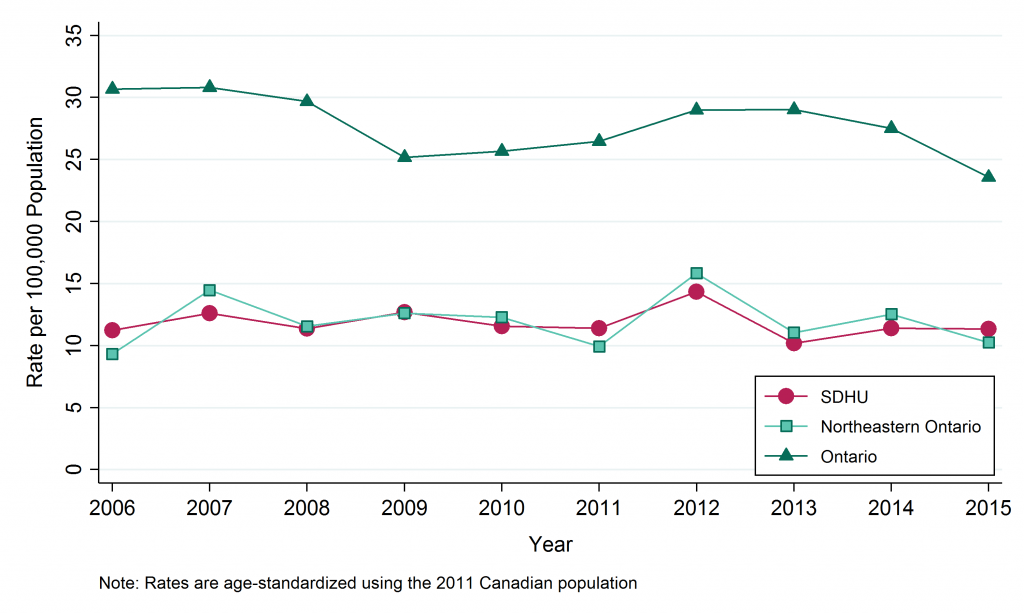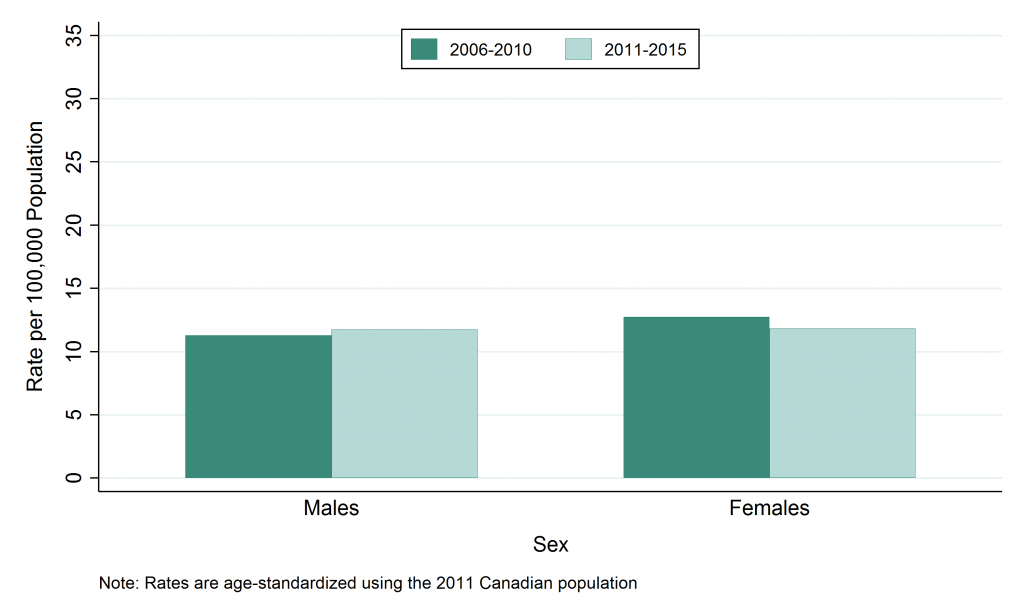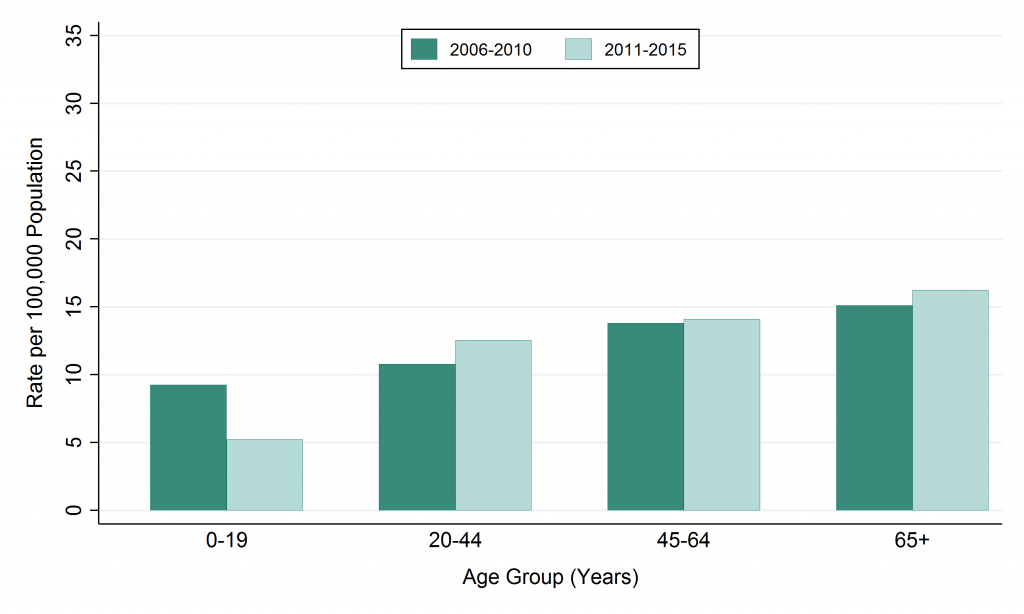Campylobacteriosis
Campylobacter is an infection of the intestines caused by bacteria. It is one of the most frequently reported food-borne infections. Symptoms usually begin 2 – 4 days after exposure and include diarrhea (frequently bloody), abdominal discomfort, fever and occasionally nausea and vomiting. Sometimes people with the infection have no symptoms.
Infection develops after ingestion of the bacteria which can be found in undercooked meat and poultry, contaminated water and other food products, or raw milk and milk products. Contact with pets, farm animals, and travel outside of Canada are also important risk factors for infection. People with weakened immune systems are at highest risk of infection.
Campylobacter infections occur throughout the year but tend to follow a seasonal pattern, increasing over the warmer months from June to October.
Campylobacteriosis cases by geographic area
Key findings:
- In the SDHU area, there were 23 confirmed cases of campylobacter in 2015.
- In 2015, the rate of campylobacter in the SDHU area was 11 per 100,000 population.
- The rate of campylobacter in the SDHU area has been similar to the rate in northeastern Ontario, while the rate in both the SDHU area and northeastern Ontario have consistently been lower than that of Ontario.
- Between 2006 and 2015, the rate of campylobacter in the SDHU area, as for northeastern Ontario and Ontario, has remained stable over time.
Notes:
- Rates are age-standardized using 2011 Canadian population.
- Data Source: Infectious Diseases Query, Public Health Ontario, Extracted Feb. 2016, and Population Estimates and Projections, Ontario Ministry of Health and Long-Term Care: IntelliHEALTH ONTARIO, Extracted Sep. 2015.
Figure: Annual age-standardized rate, campylobacteriosis, by geographic area, 2006–2015

Table: Annual age-standardized rate, campylobacteriosis, by geographic area, 2006–2015
| Geographic Region | 2006 | 2007 | 2008 | 2009 | 2010 | 2011 | 2012 | 2013 | 2014 | 2015 |
|---|---|---|---|---|---|---|---|---|---|---|
| SDHU | 11.2 | 12.6 | 11.4 | 12.7 | 11.6 | 11.4 | 14.3 | 10.2 | 11.4 | 11.3 |
| Northeast | 9.3 | 14.5 | 11.6 | 12.6 | 12.3 | 9.9 | 15.8 | 11.0 | 12.5 | 10.2 |
| Ontario | 30.7 | 30.8 | 29.7 | 25.2 | 25.7 | 26.5 | 29.0 | 29.0 | 27.5 | 23.6 |
Table: Annual number of cases of campylobacteriosis, by geographic area, 2006–2015
| Geographic Region | 2006 | 2007 | 2008 | 2009 | 2010 | 2011 | 2012 | 2013 | 2014 | 2015 |
|---|---|---|---|---|---|---|---|---|---|---|
| SDHU | 21 | 26 | 23 | 26 | 24 | 23 | 30 | 21 | 24 | 23 |
| Northeast | 52 | 82 | 67 | 75 | 71 | 59 | 95 | 65 | 74 | 59 |
| Ontario | 3874 | 3909 | 3799 | 3255 | 3367 | 3505 | 3896 | 3942 | 3781 | 3274 |
Campylobacteriosis cases by sex
Key findings:
- Between 2011 and 2015, there were a total of 60 males and 61 females diagnosed with campylobacter in the SDHU area, an average of 12 males and 12 females per year.
- In the SDHU area, the annual rate of campylobacter between 2011 and 2015 was 12 per 100,000 males and 12 per 100,000 females.
- The rate of campylobacter among females has been similar to the rate among males.
- Between the time periods 2006–2010 and 2011–2015, the rates of campylobacter has remained stable for both males and females in the SDHU area.
Notes:
- Rates are age-standardized using 2011 Canadian population.
- Data Source: Infectious Diseases Query, Public Health Ontario, Extracted Feb. 2016, and Population Estimates and Projections, Ontario Ministry of Health and Long-Term Care: IntelliHEALTH ONTARIO, Extracted Sep. 2015.
Figure: Age-standardized rate, campylobacteriosis, by sex, Sudbury & District Health Unit (SDHU), 2006–2010 and 2011–2015

Table: Age-standardized rate, campylobacteriosis, by sex, Sudbury & District Health Unit (SDHU), 2006–2010 and 2011–2015
| Sex | Rate per 100,000 2006-2010 | Rate per 100,000 2011-2015 |
|---|---|---|
| Males | 11.3 | 11.7 |
| Females | 12.7 | 11.8 |
Table: Annual number of cases of campylobacteriosis, by sex, Sudbury & District Health Unit (SDHU), 2006–2010 and 2011–2015
| Sex | Total Counts 2006-2010 | Total Counts 2011-2015 | Average Annual Counts 2006-2010 | Average Annual Counts 2011-2015 |
|---|---|---|---|---|
| Males | 55 | 60 | 11.0 | 12.0 |
| Females | 65 | 61 | 13.0 | 12.2 |
Campylobacteriosis cases by age group
Key findings:
- Between 2011 and 2015, the highest number of campylobacter cases was in the 45 to 64 age group, with a total of 43 cases or an average of 9 per year in the SDHU area.
- In the SDHU area, the highest annual rate of campylobacter was in the 65-and-over age group, with 16 cases per 100,000 population between 2011 and 2015.
- The rate of campylobacter is lowest in the 0 to 19 age group and increases with age.
- Between the time periods 2006–2010 and 2011–2015, the rate of campylobacter has remained stable in all age groups with the exception of 0 to 19 age group where there was a decrease.
Notes:
- Data Source: Infectious Diseases Query, Public Health Ontario, Extracted Feb. 2016, and Population Estimates and Projections, Ontario Ministry of Health and Long-Term Care: IntelliHEALTH ONTARIO, Extracted Sep. 2015.
Figure: Campylobacteriosis, by age group, Sudbury & District Health Unit (SDHU), 2006–2010 and 2011–2015

Table: Rate of campylobacteriosis, by age group, Sudbury & District Health Unit (SDHU), 2006–2010 and 2011–2015
| Age Group | Rate per 100,000 2006-2010 | Rate per 100,000 2011-2015 |
|---|---|---|
| 0-19 | 9.3 | 5.2 |
| 20-44 | 10.8 | 12.5 |
| 45-64 | 13.8 | 14.1 |
| 65+ | 15.1 | 16.2 |
Table: Annual number of campylobacteriosis, by age group, Sudbury & District Health Unit (SDHU), 2006–2010 and 2011–2015
| Age Group | Total Counts 2006-2010 | Total Counts 2011-2015 | Average Annual Counts 2006-2010 | Average Annual Counts 2011-2015 |
|---|---|---|---|---|
| 0-19 | 21 | 11 | 4.2 | 2.2 |
| 20-44 | 35 | 39 | 7 | 7.8 |
| 45-64 | 41 | 43 | 8.2 | 8.6 |
| 65+ | 23 | 28 | 4.6 | 5.6 |
This item was last modified on March 26, 2018
